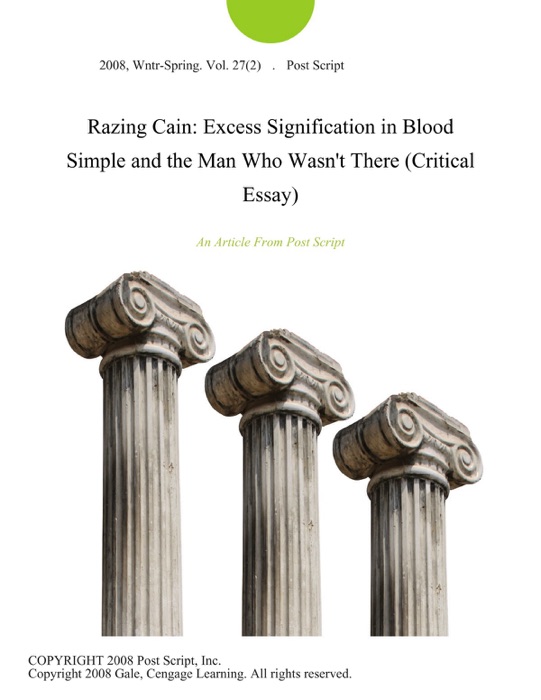(DOWNLOAD) "Razing Cain: Excess Signification in Blood Simple and the Man Who Wasn't There (Critical Essay)" by Post Script # eBook PDF Kindle ePub Free

eBook details
- Title: Razing Cain: Excess Signification in Blood Simple and the Man Who Wasn't There (Critical Essay)
- Author : Post Script
- Release Date : January 01, 2008
- Genre: Business & Personal Finance,Books,
- Pages : * pages
- Size : 280 KB
Description
Downplaying such biographical influences as sibling dynamics and "Jewish origin," Joel Coen suggests that while filmmakers like Woody Allen draw much from their own lives, he and his brother Ethan are "more interested in playing with different genres in the style of Billy Wilder" (Korte 13). And yet, as they tackle the screwball comedy, the gangster film, the road movie, and other Hollywood genres, the Coens--again like Wilder--seem interested above all else in literary and cinematic noir. Whether summoning Dashiell Hammett's Red Harvest (1929) and The Glass Key (1931) in Miller's Crossing (1990), Steve Fisher's I Wake Up Screaming (1941) in Barton Fink (1991), or Raymond Chandler's The Big Sleep (1939) in The Big Lebowski (1998), they persistently draw upon literary noir pretexts. The Coens' dialogue with noir is nowhere more clear than in Blood Simple (1984) and The Man who Wasn't There (2001), both of which adapt the fiction of James M. Cain. Each film "raises" Cain, evoking the novelist's groundplot of a murderous love-triangle, only to "raze" the realistic ethos of his high-noir texts by subverting what Roland Barthes calls "insignificant notation." Citing Fargo as a possible exception, Ethan Coen has admitted that he and his brother "were never really interested in realism or reportage or documentary-type work" (Korte 13). His remark is somewhat deceptive, though, for while he and his brother favor a formalistic mise-en-scene entirely at odds with documentary realism, they devote considerable attention to exposure of the realistic strategies endemic to noir. Film noir, of course, holds expressionist and semi-documentary techniques in tension, allowing suggestive low-key lighting and unstable compositions to operate within and against a realistic mise-en-scene (Hirsch 53)--a variety of what Barthes describes as "the reality effect." Barthes, in his 1968 essay of the same name, distinguishes between the "ancient mode of verisimilitude" and "modern realism." The former invests nothing in the purely reflective potential of representation: "plausibility is not referential here but openly discursive; it is the generic rules of the discourse which lay down the law" (144). Modern realism, on the other hand, resolutely defends the sanctity of the referent, the "real world" beyond the text. For Barthes, the realist utilizes "insignificant notation'--miscellaneous "concrete details" that appear to lie outside meaning, ultimately declaring, "we are the real":
Post a Comment for "(DOWNLOAD) "Razing Cain: Excess Signification in Blood Simple and the Man Who Wasn't There (Critical Essay)" by Post Script # eBook PDF Kindle ePub Free"